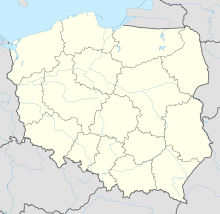Glogau Castle
Coordinates: 51 ° 40 ′ 2 " N , 16 ° 5 ′ 26" E
Glogau Castle ( Polish: Zamek Książąt Głogowskich ) is a castle in Głogów ( Glogau ) in the Lower Silesian Voivodeship in Poland .
history
To secure the ford across the Oder , there was probably already a Gauhauptburg under the West Slavic Dedosizen . A castellan ("praefectus") Woislaw is documented for the year 1124 , the associated castellany not until 1155. The castle probably consisted of a wood-earth fortification on an island in the Oder. The first cathedral church was built in this castle. Under Konrad I. der Oder, a new castle was built to the west, the dungeon is obtained from bricks in today's castle.
Under Johann I , the castle was expanded into a stone complex. During the Glogau succession dispute , the Sagan Duke Johann II occupied the city and had council members who did not recognize his rule locked in the keep. During the further military conflicts over rule in the duchy, the complex was damaged and rebuilt in 1499 by Sigismund I , who had received the duchy of Glogau as a fief from the Bohemian sovereign Vladislav II . During the great city fire of 1615, the facility was again badly damaged. Then it was removed. Only the keep and the cellars remained. Then a castle in the style of the early baroque was built on the site .
In 1669 the governor of Glogau, Johann Bernhard II von Herberstein, had a ballroom set up with a stucco ceiling depicting the Bohemian sovereign Leopold I , while the Glogau dukes were depicted on the side walls . Under Karl Graf von Kottulinsky , the exterior of the complex was further reshaped.
After the First Silesian War in 1742, Glogau and almost all of Silesia fell to Prussia . After that, the Glogau Castle was the seat of the Prussian War and Domain Chamber , and later an upper office. During the Napoleonic Wars , the palace was temporarily occupied by the Grande Armée . In 1809 the War and Domain Chamber was relocated to Liegnitz . After the occupiers left, the castle became the administrative seat and official seat of Prince Wilhelm, commandant of the 7th Infantry Regiment.
During the Second World War , the city was besieged by the Red Army until April 1945 . The castle burned down and was placed under monument protection in 1958 as “ Piastic Heritage”. Rebuilt from 1971 to 1983. A museum for archaeological and historical collections has been housed in the castle since 1992 .
literature
- Arne Franke (Hrsg.): Small cultural history of the Silesian castles . tape 1 . Bergstadtverlag Wilhelm Gottlieb Korn, 2015, p. 58-59 .

